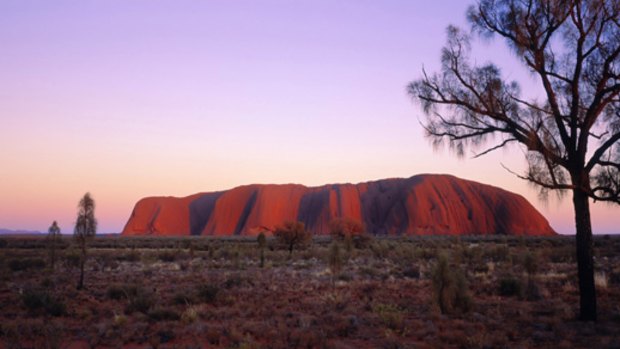The Red Centre is in the throes of a makeover aimed at attracting more visitors and upgrading facilities for the 350,000 who already flock to the destination every year.
One of the most significant developments is the Uluru-Kata Tjuta viewing area project. The first phase of this project is a new eight-kilometre road around Uluru, which opened in June last year and offers "vastly improved" views of the Rock. Because it is further away from Uluru than the old road it allows for more of an overview of the Rock than before; and there are still plenty of opportunities to get up close with Uluru. The road also improves access to the cultural centre and leads through previously inaccessible landscapes and vegetation zones surrounding Uluru.

Outback icon ... Uluru at sunrise.Credit: Tourism NT
New sunrise views
The second phase of the project is a new viewing area on the south-eastern side of the Rock, which is under construction and will open between July and September. It will replace the existing sunrise viewing area, which now attracts more than 1200 people every morning, more than it was designed for. The new area will have viewing platforms, shade structures, elevated walkways and, of course, sweeping views - not just of Uluru but of Kata Tjuta - at all times of the day, not just sunrise.
Because the new viewing area's location was decided in consultation with the World Heritage area's traditional owners, culturally sensitive sites that were visible from the original sunrise viewing area won't be visible from the new viewing area. This will make it easier for visitors to photograph Uluru at sunrise, the most spectacular time of day, without being restricted by cultural mores and park regulations designed to keep photos of sacred sites from being published.
Part of the popular Uluru base walk has also been moved and upgraded. The four-kilometre north-east section of the walk now meanders past mulga trees and desert bloodwoods, avoids sacred sites and offers better views of Uluru. Because of its firm surface, it is also suitable for cyclists wanting to ride around the Rock. The signage around the entire base walk is being improved, too, to make the walk more interesting for independent walkers.
Climbing the Rock
Climbing Uluru, while still permitted, is increasingly off the menu for responsible travellers. According to recent figures from Uluru-Kata Tjuta National Park, only 38 per cent of park visitors choose to climb Uluru each year, down from 74 per cent in 1990. Japanese visitors are the most likely to climb it; German, US and Scandinavian visitors are the least likely.
The most common reason given for not climbing is the desire to respect the area's indigenous culture and the wishes of the Anangu, who ask visitors not to climb Uluru because of its spiritual significance.
The long way round
The way people get to Uluru is also changing, thanks to the upgrading of the Red Centre Way. This 662-kilometre network of roads linking Alice Springs and Uluru is being sealed progressively to entice tourists into the countryside west of Alice.
Negotiations with key stakeholders such as the Central Land Council are under way in relation to the final section - the 200-kilometre Mereenie Loop Road from Glen Helen Gorge to Kings Canyon - but no deadline has been announced.
In the meantime, more and more visitors to the Red Centre are already opting for "the long way round" from Alice to Uluru, or vice versa. Instead of simply flying to Uluru or driving direct from Alice , they're spending a week or more on the Red Centre Way, visiting central Australian landmarks en route, such as Simpson's Gap, Standley Chasm, Glen Helen Gorge, Kings Canyon and the West MacDonnell Ranges, which are being assessed for possible world heritage listing.
Greening the Red Centre
In response to growing demand for "greener" travel, Tourism NT has been developing a number of sustainable tourism initiatives in the Red Centre - such as a 12-month carbon offset pilot program called Outback Offsets, the first of its kind in Australia. Until June 30, clients booking tours in central Australia with the three participating tour operators - Adventure Tours Australia, Connections Safaris and Wayoutback Desert Safaris - can have their travel offset free of charge; the operators are also reducing and offsetting their own emissions in order to be carbon neutral by June 30.
Given its sun-drenched location (Alice Springs gets about 300 days of sunshine a year), it's not surprising that the Red Centre is positioning itself as Australia's solar-energy capital, which is having an impact on tourism in the area.
In March last year, Alice Springs was chosen for the Federal Government's $37million Solar Cities program, which offers residents and businesses advice and financial incentives to encourage uptake of sustainable energy. Almost a third of all Alice Springs-based businesses signing up to the program are involved in tourism; Crowne Plaza Alice Springs, for instance, installed a $3million solar energy system, which will generate up to 80 per cent of the hotel's energy needs.
And in October last year, Alice Springs's $3.1million Desert Knowledge Australia Solar Centre opened to the public, the first site in Australia to showcase a range of large-scale working solar installations.
Sign up for the Traveller Deals newsletter
Get exclusive travel deals delivered straight to your inbox. Sign up now.